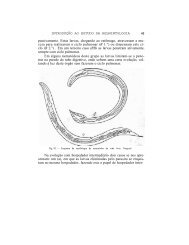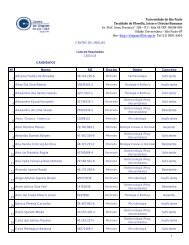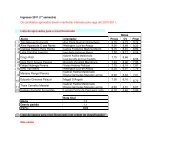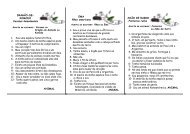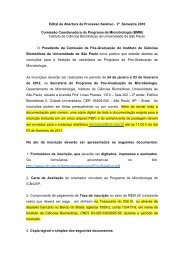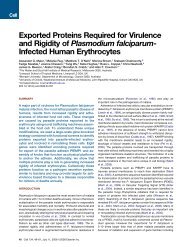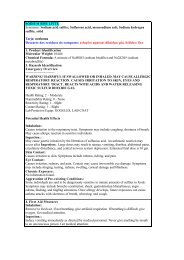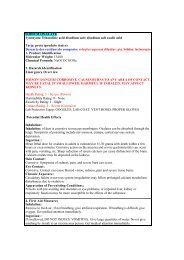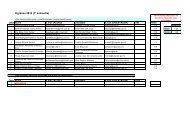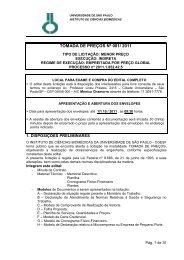SODIUM NITRATE Synonyms: Nitratine; nitric acid, sodium ... - USP
SODIUM NITRATE Synonyms: Nitratine; nitric acid, sodium ... - USP
SODIUM NITRATE Synonyms: Nitratine; nitric acid, sodium ... - USP
- No tags were found...
You also want an ePaper? Increase the reach of your titles
YUMPU automatically turns print PDFs into web optimized ePapers that Google loves.
<strong>SODIUM</strong> <strong>NITRATE</strong><strong>Synonyms</strong>: <strong>Nitratine</strong>; <strong>nitric</strong> <strong>acid</strong>, <strong>sodium</strong> salt; <strong>sodium</strong> saltpeter; <strong>sodium</strong> nitrate, crystalTarja: nenhumaDescarte dos resíduos do composto: soluções aquosas diluídas: pia. Sólidos: lixo1. Product IdentificationMolecular Weight: 84.99Chemical Formula: NaNO33. Hazards IdentificationEmergency Overview--------------------------DANGER! STRONG OXIDIZER. CONTACT WITH OTHER MATERIAL MAYCAUSE FIRE. HARMFUL IF SWALLOWED OR INHALED. MAY CAUSEIRRITATION TO SKIN, EYES, AND RESPIRATORY TRACT.Health Rating: 1 - SlightFlammability Rating: 0 - NoneReactivity Rating: 3 - Severe (Oxidizer)Contact Rating: 1 - SlightLab Protective Equip: GOGGLES; LAB COATPotential Health EffectsInhalation::Inhalation: of dust irritates the respiratory tract. Symptoms may include coughing, shortnessof breath.Ingestion::May cause gastroenteritis and abdominal pains. Other symptoms may include dizziness,bloody diarrhea, convulsions, and collapse. Purging and diuresis can be expected. Smallrepeated doses may cause headache and mental impairment. Rare cases of nitrates beingconverted to the more toxic nitrites have been reported, mostly with infants.Skin Contact:May cause irritation, symptoms including redness, itching, and pain.Eye Contact:May cause irritation, symptoms including redness, itching, and pain.Chronic Exposure:Under some circumstances methemoglobinemia occurs in individuals when the nitrate isconverted by bacteria in the stomach to nitrite. Nausea, vomiting, dizziness, rapid heart beat,irregular breathing, convulsions, coma, and death can occur should this conversion take place.Aggravation of Pre-existing Conditions:Workers with a history of kidney or lung disease may be more susceptible to the effects of thissubstance.4. First Aid MeasuresInhalation::Remove to fresh air. Get medical attention for any breathing difficulty.Ingestion::Induce vomiting immediately as directed by medical personnel. Never give anything by mouthto an unconscious person. Get medical attention.Skin Contact:Clothing
Remove any contaminated Clothing. Wipe off excess from skin. Wash skin with soap andwater for at least 15 minutes. Get medical attention if irritation develops or persists.Eye Contact:Immediately flush eyes with plenty of water for at least 15 minutes, lifting lower and uppereyelids occasionally. Get medical attention immediately.5. Fire Fighting MeasuresFire:Not combustible, but substance is a strong oxidizer and its heat of reaction with reducingagents or combustibles may cause ignition.Explosion:Explosive with shock, heat or friction. Sodium Nitrate decomposes explosively when heated >538C (1000F). Sensitive to mechanical impact.Fire Extinguishing Media:Use any means suitable for extinguishing surrounding fire. Water spray may be used to keepfire exposed containers cool.Special Information:Wear full protective Clothing and breathing equipment for high-intensity fire or potentialexplosion conditions. This oxidizing material can increase the flammability of adjacentcombustible materials.6. Accidental Release MeasuresRemove all sources of ignition. Ventilate area of leak or spill. Wear appropriate personalprotective equipment as specified in Section 8. Spills: Clean up spills in a manner that does notdisperse dust into the air. Use non-sparking tools and equipment. Reduce airborne dust andprevent scattering by moistening with water. Pick up spill for recovery or disposal and place ina closed container. Small amounts of residue may be flushed to sewer with plenty of water.7. Handling: and Sto rageKeep in a tightly closed container, stored in a cool, dry, ventilated area. Protect againstphysical damage and moisture. Isolate from any source of heat or ignition. Avoid Storage onwood floors. Separate from incompatibles, combustibles, organic or other readily oxidizablematerials. Containers of this material may be hazardous when empty since they retain productresidues (dust, solids); observe all warnings and precautions listed for the product.8. Exposure Controls/Personal ProtectionAirborne Exposure Limits:None established.Ventilation System:A system of local and/or general exhaust is recommended to keep employee exposures as lowas possible. Local exhaust ventilation is generally preferred because it can control theemissions of the contaminant at its source, preventing dispersion of it into the general workarea. Please refer to the ACGIH document, Industrial Ventilation, A Manual of RecommendedPractices, most recent edition, for details.Personal Respirators (NIOSH Approved):For conditions of use where exposure to dust or mist is apparent and engineering controls arenot feasible, a particulate respirator (NIOSH type N95 or better filters) may be worn. If oilparticles (e.g. lubricants, cutting fluids, glycerine, etc.) are present, use a NIOSH type R or Pfilter. For emergencies or instances where the exposure levels are not known, use a full-facepositive-pressure, air-supplied respirator. WARNING: Air-purifying Respirators do notprotect workers in oxygen-deficient atmospheres.
Skin Protection:Wear impervious protective Clothing, including boots, gloves, lab coat, apron or coveralls, asappropriate, to prevent skin contact.Eye Protection:Use chemical safety goggles and/or full face shield where dusting or splashing of solutions ispossible. Maintain eye wash fountain and quick-drench facilities in work area.9. Physical and Chemical PropertiesAppearance: White crystals.Odor: Odorless.Solubility: 81.5 g/100 g water @ 15C (59F)Specific Gravity: 2.26pH: Aqueous solution is neutral.% Volatiles by volume @ 21C (70F): 0Boiling Point: 380C (716F)Melting Point: 308C (586F)10. Stability and ReactivityStability:Stable under ordinary conditions of use and Storage.Hazardous Decomposition Products:Emits nitrous oxides when heated to decomposition.Hazardous Polymerization:Will not occur.Incompatibilities:Reacts with <strong>acid</strong>s to emit toxic fumes of nitrogen dioxide. Contact with the following maycause an explosion: barium rhodanide, boron phosphide, cyanides, <strong>sodium</strong> thiosulfate, <strong>sodium</strong>hypophosphite, sulfur plus charcoal, powdered aluminum and aluminum oxide. Fibrousorganic material such as jute, wood, and similar cellulosic materials can become highlycombustible by nitrate impregnation.Conditions to Avoid:Heat, flame, ignition sources, shock, friction, incompatibles.11. Toxicological InformationOral rat LD50: 1267 mg/kg. Investigated as a tumorigen, mutagen, reproductive effector.



